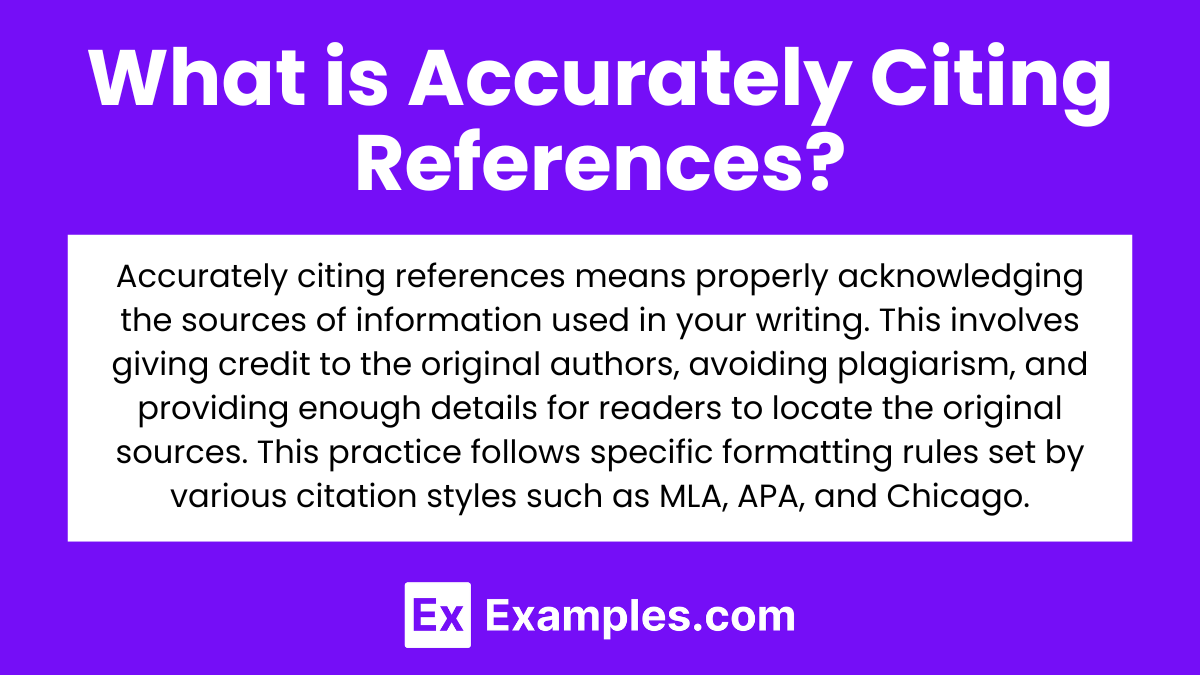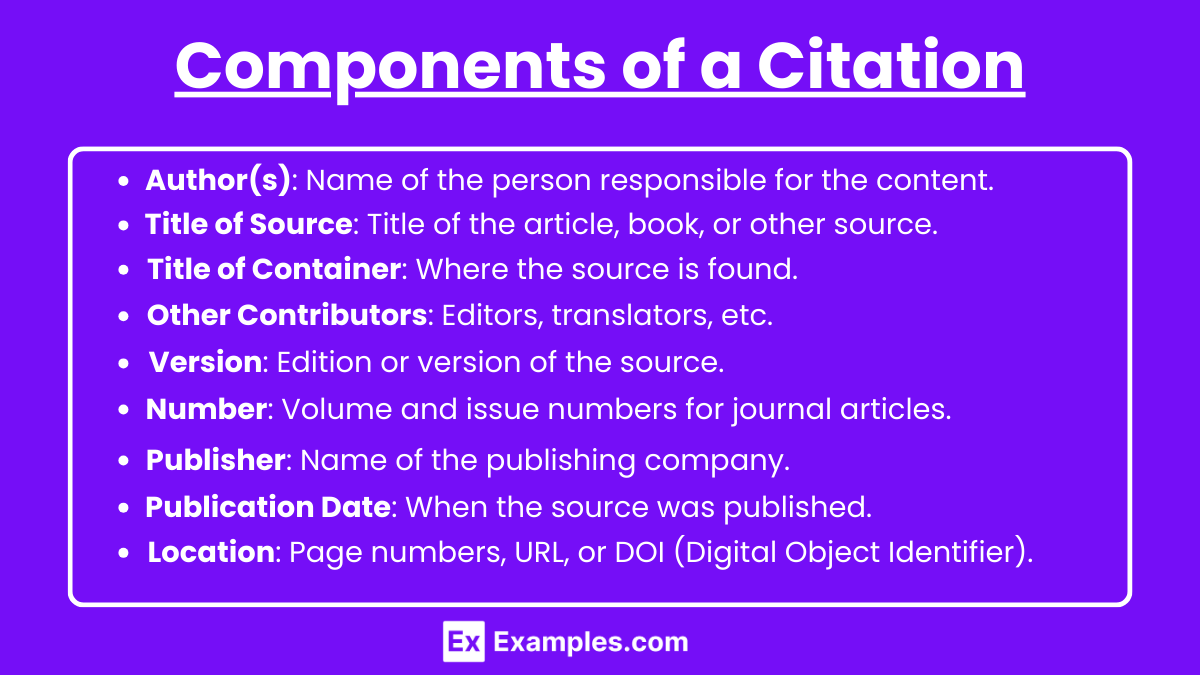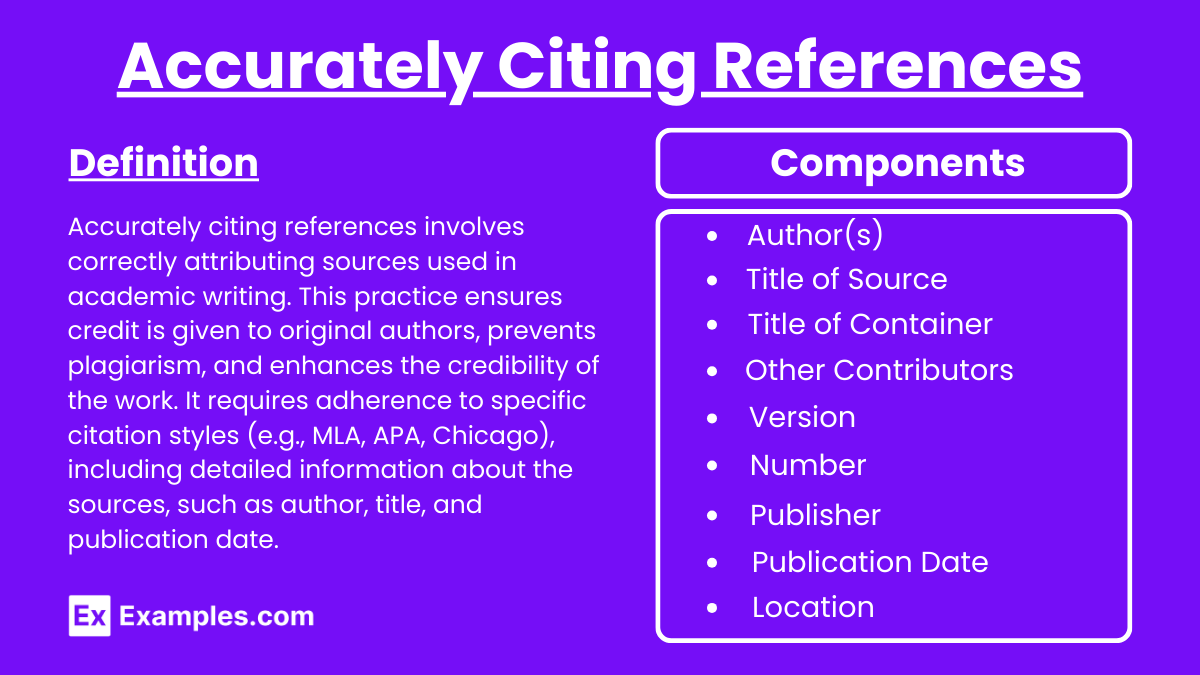Accurately citing references is a fundamental skill in academic writing that ensures the credibility and integrity of your work. In the realm of AP English Language and Composition, understanding how to properly cite sources is crucial for several reasons. Proper citation acknowledges the original authors of the information you use, thereby avoiding plagiarism and respecting intellectual property. Additionally, well-cited references enhance the persuasiveness of your arguments by backing them with reliable sources, demonstrating thorough research and adherence to academic standards.
Learning Objectives
By studying the topic of accurately citing references, students will achieve several key learning objectives. They will understand the importance of citation in academic writing, recognizing its role in giving credit to original authors and avoiding plagiarism. Students will become proficient in various citation styles, including MLA, APA, and Chicago/Turabian, and will learn to identify and apply the essential components of a citation. They will develop skills to integrate in-text citations correctly and compile comprehensive Works Cited or References pages. Additionally, students will learn to use citation tools effectively and avoid common citation errors. Overall, these skills will enhance their ability to produce credible, well-researched, and academically sound essays and research papers.
What is Accurately Citing References?
Accurately citing references means properly identifying and crediting the sources of information, ideas, and quotes used in your work. This practice involves following specific formatting guidelines of citation styles such as MLA, APA, or Chicago citation to ensure that all relevant details—like author, title, publication date, and location—are included. This helps avoid plagiarism, supports the credibility of your work, and allows readers to verify and locate the original sources.

Understanding Citation Styles
- MLA (Modern Language Association): Commonly used in humanities. Focuses on author-page format.
- APA (American Psychological Association): Used in social sciences. Emphasizes author-date format.
- Chicago/Turabian: Used in history and some other disciplines. Offers two systems: Notes and Bibliography, and Author-Date.
Components of a Citation
- Author(s): Name of the person or organization responsible for the content.
- Title of Source: Title of the article, book, or other source.
- Title of Container: For articles, the title of the journal, book, or website where the source is found.
- Other Contributors: Editors, translators, etc.
- Version: Edition or version of the source.
- Number: Volume and issue numbers for journal articles.
- Publisher: Name of the publishing company.
- Publication Date: When the source was published.
- Location: Page numbers, URL, or DOI (Digital Object Identifier).

In-Text Citations
- MLA: (Author’s Last Name Page Number). Example: (Smith 123).
- APA: (Author’s Last Name, Year). Example: (Smith, 2020).
- Chicago/Turabian: Author-Date uses (Author’s Last Name Year, Page Number). Example: (Smith 2020, 123). Notes and Bibliography uses footnotes or endnotes.
Works Cited/References/Bibliography
- MLA:
Smith, John. Title of Book. Publisher, Year. - APA:
Smith, J. (Year). Title of book. Publisher. - Chicago/Turabian (Author-Date):
Smith, John. Year. Title of Book. Place of Publication: Publisher.
Common Citation Formats
- Books:
- MLA: Author(s). Title of Book. Publisher, Year of Publication.
- APA: Author(s). (Year of Publication). Title of book. Publisher.
- Chicago: Author(s). Title of Book. Place of Publication: Publisher, Year of Publication.
- Journal Articles:
- MLA: Author(s). “Title of Article.” Title of Journal, vol. number, no. number, Year, pages.
- APA: Author(s). (Year). Title of article. Title of Journal, volume number(issue number), page range.
- Chicago: Author(s). “Title of Article.” Title of Journal volume number, no. issue number (Year): pages.
- Websites:
- MLA: Author(s). “Title of Webpage.” Website Name, Publisher, Date of Publication, URL.
- APA: Author(s). (Year, Month Date). Title of webpage. Website Name. URL
- Chicago: Author(s). “Title of Webpage.” Website Name. Last modified Month Date, Year. URL.
Using Citation Tools
- Online tools like Zotero, EndNote, and citation generators like EasyBib, Citation Machine, and Purdue OWL can help format citations accurately.
- Always double-check the generated citations against the latest edition of the relevant style guide.
Avoiding Common Mistakes
- Ensure the author’s name is correctly spelled.
- Use the correct title format (italicize or use quotation marks as required).
- Include all necessary publication details.
- For online sources, prefer DOIs over URLs when available.
- Be consistent with the citation style throughout your paper.
Integrating Quotations and Paraphrasing
- Introduce quotations with a signal phrase that includes the author’s name.
- Use quotation marks for direct quotes and provide an in-text citation immediately after.
- For paraphrasing, rewrite the information in your own words and include an in-text citation.
Creating a Works Cited/References Page
- Start on a new page at the end of your paper.
- Title the page “Works Cited” (MLA), “References” (APA), or “Bibliography” (Chicago).
- Double-space all entries and use a hanging indent for each entry.
- List sources alphabetically by the author’s last name.
Practice and Review
- Review the latest edition of the relevant style guide (MLA Handbook, APA Publication Manual, Chicago Manual of Style).
- Practice creating citations for different types of sources.
- Seek feedback from teachers or use writing centers for additional guidance.


